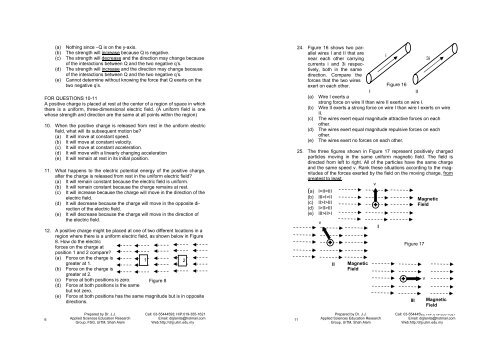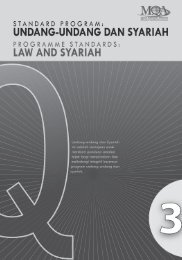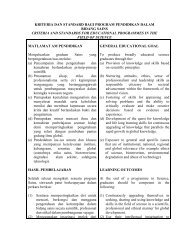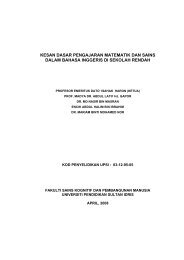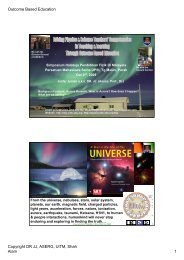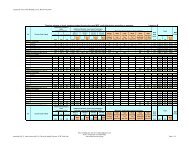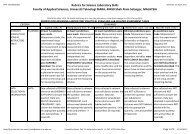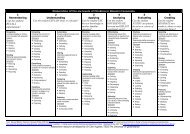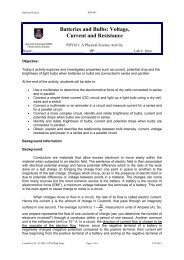Basic Physics II Evidences - DrJJ - UiTM
Basic Physics II Evidences - DrJJ - UiTM
Basic Physics II Evidences - DrJJ - UiTM
You also want an ePaper? Increase the reach of your titles
YUMPU automatically turns print PDFs into web optimized ePapers that Google loves.
(a) Nothing since –Q is on the y-axis.(b) The strength will increase because Q is negative.(c) The strength will decrease and the direction may change becauseof the interactions between Q and the two negative q’s.(d) The strength will increase and the direction may change becauseof the interactions between Q and the two negative q’s.(e) Cannot determine without knowing the force that Q exerts on thetwo negative q’s.FOR QUESTIONS 10-11A positive charge is placed at rest at the center of a region of space in whichthere is a uniform, three-dimensional electric field. (A uniform field is onewhose strength and direction are the same at all points within the region)10. When the positive charge is released from rest in the uniform electricfield, what will its subsequent motion be?(a) It will move at constant speed.(b) It will move at constant velocity.(c) It will move at constant acceleration.(d) It will move with a linearly changing acceleration(e) It will remain at rest in its initial position.11. What happens to the electric potential energy of the positive charge,after the charge is released from rest in the uniform electric field?(a) It will remain constant because the electric field is uniform.(b) It will remain constant because the charge remains at rest.(c) It will increase because the charge will move in the direction of theelectric field.(d) It will decrease because the charge will move in the opposite directionof the electric field.(e) It will decrease because the charge will move in the direction ofthe electric field.12. A positive charge might be placed at one of two different locations in aregion where there is a uniform electric field, as shown below in Figure8. How do the electricforces on the charge atposition 1 and 2 compare?(a) Force on the charge isgreater at 1.1 2(b) Force on the charge isgreater at 2.(c) Force at both positions is zero. Figure 8(d) Force at both positions is the samebut not zero.(e) Force at both positions has the same magnitude but is in oppositedirections.24. Figure 16 shows two parallelwires I and <strong>II</strong> that arenear each other carryingcurrents i and 3i respectively,both in the samedirection. Compare theforces that the two wiresexert on each other.iFigure 163i<strong>II</strong>I(a) Wire I exerts astrong force on wire <strong>II</strong> than wire <strong>II</strong> exerts on wire I.(b) Wire <strong>II</strong> exerts a strong force on wire I than wire I exerts on wire<strong>II</strong>.(c) The wires exert equal magnitude attractive forces on eachother.(d) The wires exert equal magnitude repulsive forces on eachother.(e) The wires exert no forces on each other.25. The three figures shown in Figure 17 represent positively chargedparticles moving in the same uniform magnetic field. The field isdirected from left to right. All of the particles have the same chargeand the same speed v. Rank these situations according to the magnitudesof the forces exerted by the field on the moving charge, fromgreatest to least.v(a) I=<strong>II</strong>=<strong>II</strong>I(b) <strong>II</strong>I>I><strong>II</strong>Magnetic(c) <strong>II</strong>>I><strong>II</strong>IField(d) I><strong>II</strong>><strong>II</strong>I(e) <strong>II</strong>I><strong>II</strong>>Iv<strong>II</strong>MagneticFieldIFigure 17<strong>II</strong>IvMagneticField6Prepared by Dr. J.J.Applied Sciences Education ResearchGroup, FSG, <strong>UiTM</strong>, Shah AlamCall: 03-55444593; H/P:019-355-1621Email: drjjlanita@hotmail.comWeb:http://drjj.uitm.edu.my11Prepared by Dr. J.J.Applied Sciences Education ResearchGroup, <strong>UiTM</strong>, Shah AlamCall: 03-55444593; H/P:019-355-1621Email: drjjlanita@hotmail.comWeb:http:/drjj.uitm.edu.my


